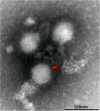Isolation and complete nucleotide sequence of a Batai virus strain in Inner Mongolia, China
- PMID: 25100223
- PMCID: PMC4127039
- DOI: 10.1186/1743-422X-11-138
Isolation and complete nucleotide sequence of a Batai virus strain in Inner Mongolia, China
Abstract
Background: Batai virus (BATV) is a member of the Orthobunyavirus genus of the family Bunyaviridae, and a vector-borne pathogen. Genomic variations of BATV exist in different regions of the world, due to genetic reassortment. Whole-genome sequencing of any isolate is necessary for a phylogenetic analysis. In 1998, a BATV strain was isolated from an Anopheles philippines mosquito in Yunnan Province, China. This strain has not been found to infect any other host. We investigated BATV infection in cattle in Inner Mongolia, China and performed deep sequencing of the genome of the BATV isolate.
Findings: Ninety-five blood samples were collected from cattle in Inner Mongolia, China in 2012. The BATV infection rate was 2.1%. Previously, BATV strain NM/12 was isolated from two cattle in Inner Mongolia, China, and the whole genomic sequence of the strain has been available. We determined the complete genomic nucleotide sequences of the small (S), medium (M), and large (L) genome segments using bovine blood obtained in 2012, and the nucleotide homologies of these segments with those from GenBank were 88.7%-97%, 84%-95.4%, and 72.6%-95.8%, respectively. The deduced amino acid identities were 87.2-99.7%, 64.2-96.8%, and 81.1-98.6%. Phylogenetic analyses based on full-length genomic sequences indicated that the M and L segments, and a portion of the S segment, of NM/12 are most closely related to the BATV strains isolated in Asia. The S and M segments of NM/12 were independent of phylogenetic lineages. The L segment was the most closely related to Chittoor/IG-20217 (isolated in India), and distantly related to isolated strains in Italy. Nucleotide substitution rates in the nucleotide sequences that code for the nucleocapsid, envelope glycoprotein, and polymerase protein of NM/12 strain were 2.56%, 4.69%, and 4.21%, respectively, relative to the original strain of MM2222.
Conclusion: A novel BATV NM/12 strain from bovine serum collected in Inner Mongolia was isolated from cattle in China for the first time. Our findings elucidate the evolutionary status of the BATV NM/12 strain among different orthobunyavirus strains and may provide some clues to prevent the emergence of BATV infection in cattle and humans.
Figures



Similar articles
-
A Review of Bunyamwera, Batai, and Ngari Viruses: Understudied Orthobunyaviruses With Potential One Health Implications.Front Vet Sci. 2018 Apr 12;5:69. doi: 10.3389/fvets.2018.00069. eCollection 2018. Front Vet Sci. 2018. PMID: 29707545 Free PMC article. Review.
-
Characterization of Batai virus isolated from a domestic Muscovy duck (Cairina moschate).Virus Genes. 2017 Feb;53(1):121-125. doi: 10.1007/s11262-016-1400-4. Epub 2016 Oct 12. Virus Genes. 2017. PMID: 27734222
-
[Complete genome analysis of the Batai virus (BATV) and the new Anadyr virus (ANADV) of the Bunyamwera group (Bunyaviridae, Orthobunyavirus) isolated in Russia].Vopr Virusol. 2014;59(6):16-22. Vopr Virusol. 2014. PMID: 25929031 Russian.
-
Complete genome sequencing of four geographically diverse strains of Batai virus.J Virol. 2012 Dec;86(24):13844-5. doi: 10.1128/JVI.02641-12. J Virol. 2012. PMID: 23166251 Free PMC article.
-
Batai Orthobunyavirus: An Emerging Mosquito-Borne Virus in Europe.Viruses. 2022 Aug 25;14(9):1868. doi: 10.3390/v14091868. Viruses. 2022. PMID: 36146674 Free PMC article. Review.
Cited by
-
A mini-review of Bunyaviruses recorded in India.Indian J Med Res. 2017 May;145(5):601-610. doi: 10.4103/ijmr.IJMR_1871_15. Indian J Med Res. 2017. PMID: 28948950 Free PMC article. Review.
-
Comparative characterization of the reassortant Orthobunyavirus Ngari with putative parental viruses, Bunyamwera and Batai: in vitro characterization and ex vivo stability.J Gen Virol. 2021 Feb;102(2):001523. doi: 10.1099/jgv.0.001523. J Gen Virol. 2021. PMID: 33258753 Free PMC article.
-
Blood meal acquisition enhances arbovirus replication in mosquitoes through activation of the GABAergic system.Nat Commun. 2017 Nov 2;8(1):1262. doi: 10.1038/s41467-017-01244-6. Nat Commun. 2017. PMID: 29093445 Free PMC article.
-
Monitoring for bovine arboviruses in the most southwestern islands in Japan between 1994 and 2014.BMC Vet Res. 2016 Jun 24;12(1):125. doi: 10.1186/s12917-016-0747-z. BMC Vet Res. 2016. PMID: 27342576 Free PMC article.
-
A Review of Bunyamwera, Batai, and Ngari Viruses: Understudied Orthobunyaviruses With Potential One Health Implications.Front Vet Sci. 2018 Apr 12;5:69. doi: 10.3389/fvets.2018.00069. eCollection 2018. Front Vet Sci. 2018. PMID: 29707545 Free PMC article. Review.
References
-
- Karabatos N. International Catalogue of Arboviruses. Northbrooke, IL: American Society of Tropical Medicine and Hygiene; 1985.
-
- Yanase T, Kato T, Yamakawa M, Takayoshi K, Nakamura K, Kokuba T, Tsuda T. Genetic characterization of Batai virus indicates a genomic reassortment between orthobunyaviruses in nature. Arch Virol. 2006;151:2253–2260. - PubMed
-
- Tsuda T. Congenital abnormalities of cattle caused by the arboviral infection. Yamaguchi J Vet Med. 2000;27:1–18.
Publication types
MeSH terms
Substances
Associated data
- Actions
- Actions
- Actions
LinkOut - more resources
Full Text Sources
Other Literature Sources
Molecular Biology Databases

